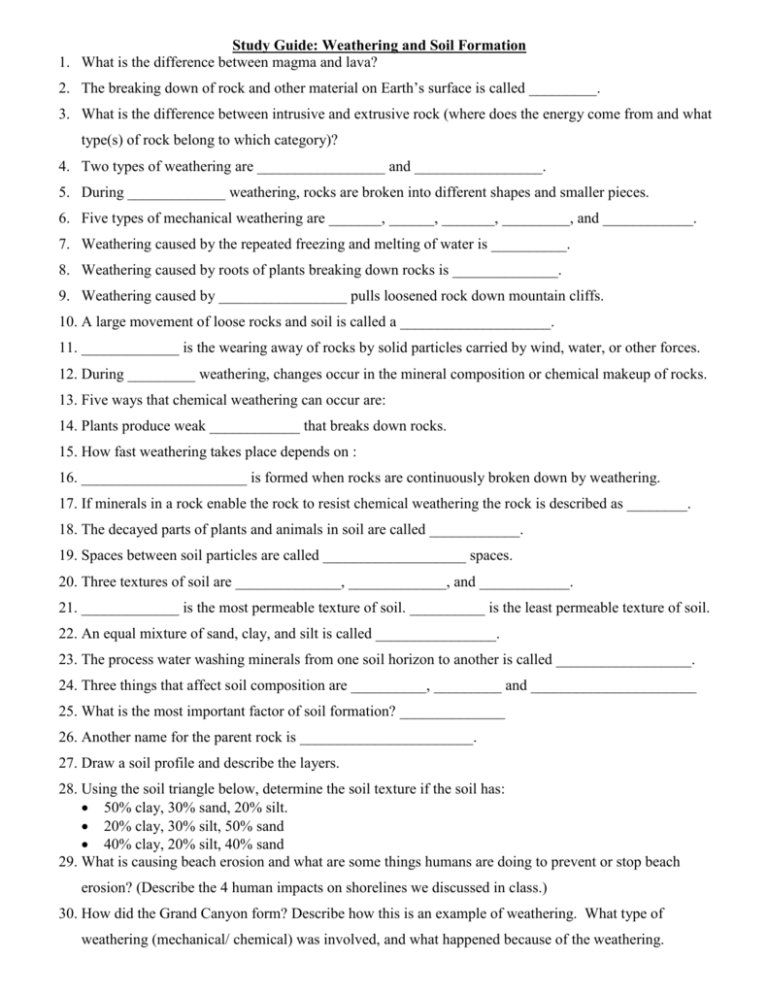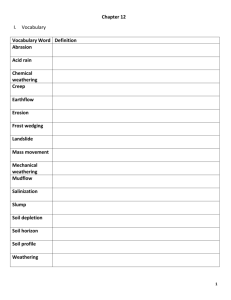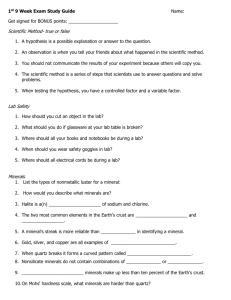Study Guide Chapter 14 Weathering and Soil Formation
advertisement

Study Guide: Weathering and Soil Formation 1. What is the difference between magma and lava? 2. The breaking down of rock and other material on Earth’s surface is called _________. 3. What is the difference between intrusive and extrusive rock (where does the energy come from and what type(s) of rock belong to which category)? 4. Two types of weathering are _________________ and _________________. 5. During _____________ weathering, rocks are broken into different shapes and smaller pieces. 6. Five types of mechanical weathering are _______, ______, _______, _________, and ____________. 7. Weathering caused by the repeated freezing and melting of water is __________. 8. Weathering caused by roots of plants breaking down rocks is ______________. 9. Weathering caused by _________________ pulls loosened rock down mountain cliffs. 10. A large movement of loose rocks and soil is called a ____________________. 11. _____________ is the wearing away of rocks by solid particles carried by wind, water, or other forces. 12. During _________ weathering, changes occur in the mineral composition or chemical makeup of rocks. 13. Five ways that chemical weathering can occur are: 14. Plants produce weak ____________ that breaks down rocks. 15. How fast weathering takes place depends on : 16. ______________________ is formed when rocks are continuously broken down by weathering. 17. If minerals in a rock enable the rock to resist chemical weathering the rock is described as ________. 18. The decayed parts of plants and animals in soil are called ____________. 19. Spaces between soil particles are called ___________________ spaces. 20. Three textures of soil are ______________, _____________, and ____________. 21. _____________ is the most permeable texture of soil. __________ is the least permeable texture of soil. 22. An equal mixture of sand, clay, and silt is called ________________. 23. The process water washing minerals from one soil horizon to another is called __________________. 24. Three things that affect soil composition are __________, _________ and ______________________ 25. What is the most important factor of soil formation? ______________ 26. Another name for the parent rock is _______________________. 27. Draw a soil profile and describe the layers. 28. Using the soil triangle below, determine the soil texture if the soil has: 50% clay, 30% sand, 20% silt. 20% clay, 30% silt, 50% sand 40% clay, 20% silt, 40% sand 29. What is causing beach erosion and what are some things humans are doing to prevent or stop beach erosion? (Describe the 4 human impacts on shorelines we discussed in class.) 30. How did the Grand Canyon form? Describe how this is an example of weathering. What type of weathering (mechanical/ chemical) was involved, and what happened because of the weathering. Good Soil Quality:








